| Quezon Memorial Circle | |
|---|---|
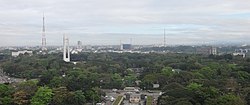 Shot of the Quezon Memorial Circle from the City Hall Shot of the Quezon Memorial Circle from the City Hall | |
 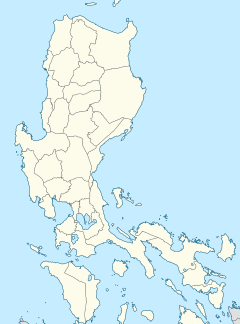  | |
| Type | Urban Park |
| Location | Elliptical Road, Diliman, Quezon City, Philippines |
| Coordinates | 14°39′05.1″N 121°02′57″E / 14.651417°N 121.04917°E / 14.651417; 121.04917 |
| Area | 27 hectares (67 acres) |
| Created | 1978 |
| Administered by | Quezon City Government (Majority; 26 hectares (64 acres)) National Historical Commission of the Philippines (Quezon Memorial Shrine area; 1 hectare (2.5 acres)) |
| Public transit access | Future: |
| Website | https://www.quezoncity.gov.ph/ |
The Quezon Memorial Circle, a national park situated in Quezon City, Philippines is a prominent landmark located within a large elliptical traffic circle bounded by the Elliptical Road. Serving as the main park of Quezon City, which was the official capital of the Philippines from 1948 to 1976, the park is renowned for its centerpiece: a 66-meter (217 ft) tall mausoleum. This monument enshrines the remains of Manuel L. Quezon, the second official President of the Philippines and the first president of an internationally recognized independent Philippines, alongside his wife, First Lady Aurora Quezon.
The Quezon Memorial Circle is also set to become a pivotal point in the Manila Metro Rail Transit System with the construction of the Quezon Memorial MRT station, which will be an underground facility on the approved MRT Line 7.
Locally referred to as the "Circle," the park has recently undergone substantial enhancements led by the local government to attract more visitors, both local and international. These beautification efforts have significantly boosted the number of visitors to the park.
History
Originally conceived as the site for the National Capitol in Quezon City, the Quezon Memorial circle was intended to house the Congress of the Philippines. This location was part of a broader plan for a National Government Center (NGC) encompassing Elliptical Road and the Quezon City Quadrangle, which includes the North, South, East, and West Triangles. The NGC aimed to consolidate the three branches of the Philippine government—legislative, executive, and judicial—into a single area. However, while the cornerstone was laid on November 15, 1940, construction halted due to the outbreak of World War II in the Philippines, leaving only the foundations completed.
In December 1945, following the end of World War II, President Sergio Osmeña issued Executive No. 79 to form the Quezon Memorial Committee. This committee was tasked with raising public funds to build a memorial in honor of his predecessor, President Manuel L. Quezon.
Former Quezon City Mayor Tomas Morato played a crucial role in selecting the memorial's site. Although President Elpidio Quirino later proposed relocating the monument, Morato strongly opposed this idea. His opposition led him to resign as the congressman representing the 2nd district of Quezon Province in 1949 over disputes with Quirino's plan.
In 1951, a national contest for the Quezon Memorial Project was held, with Filipino architect Federico Ilustre emerging as the winner. His design included not only the monument but also plans for a presidential library, a museum, and a theater.
The undeveloped grounds of Quezon Memorial Circle saw significant events, including a public mass celebrated by Pope Paul VI in 1970.
Following the People Power Revolution in 1986, the Quezon City Parks Development Foundation (QCPDF) was established under Mayor Brigido Simon Jr. Through a tripartite agreement involving the Quezon City government, the National Historical Institute (now the National Historical Commission of the Philippines), and the National Parks Development Administration (NPDA), the NPDA gained jurisdiction over the park's 27 hectares (67 acres). However, the Quezon Memorial Shrine remained under the National Historical Institute's control. The NPDA subsequently transferred park management to the QCPDF, which was authorized to generate revenue for its upkeep.
In the 1980s, the architecture firm led by Francisco Mañosa developed a master plan for the park, reflecting its evolving role as a central urban space. On July 1, 2008, after managing the park since September 27, 1988, the QCPDF handed over management responsibilities to the Quezon City government.
During the COVID-19 pandemic, the park adapted to meet critical needs by providing makeshift dormitories for health workers from nearby hospitals and serving as a testing site.
Park lay-out
Quezon Memorial Shrine
Main article: Quezon Memorial ShrineThe Quezon Memorial Shrine is an art deco-themed monument designed by Federico Ilustre and was built during the 1950s – serving as the centerpiece of the Quezon Memorial Circle. The 66-meter (217 ft) shrine representing Quezon's age when he died from tuberculosis stands on a thirty-six hectare elliptical lot. It houses an observation deck that can accommodate sixty people at the top through a spiral staircase which gives the visitors a panoramic view of the city.

At the top of the pylons are three mourning angels holding sampaguita (the national flower) wreaths sculpted by the Italian sculptor Francesco Monti. The regional identity of each female angels figure could be discerned in the traditional costume they were clothed with. The winged figures atop the three pylons represented Luzon, Visayas, and Mindanao. The three pylons would in turn circumscribe a drum-like two-story structure containing a gallery from which visitors could look down at Quezon's catafalque, modeled after Napoleon Bonaparte's in the Invalides. The gallery and the catafalque below are lit by an oculus, in turn reminiscent of Grant's Tomb.
Museums
Further information: QCX, Quezon Heritage House, Museo ni Manuel L. Quezon, and Presidential Car Museum
The planned auxiliary structures (presidential library, museum, and theater) were never built. Two smaller museums, one containing the presidential memorabilia of Quezon, and the other containing items on the history of Quezon City, were installed within the Shrine itself. In the 1980s, missing, lost, or incomplete bas reliefs for the outside of the memorial were installed.
A house of Manuel L. Quezon family in Gilmore, New Manila was transferred within the Quezon Memorial Circle and was made a museum. A city museum, the Quezon City Experience (QCX) was also opened within park grounds in late 2015.
The Presidential Car Museum, housing the presidential cars of former Philippine presidents, was inaugurated on August 19, 2018.
Recreation spaces
Quezon City Circle also hosts the Circle of Fun, a small amusement park which has various rides such as the "Fun Drop" a drop tower ride and the "Sea Dragon", a pirate ship type of amusement ride. A separate attraction, the Pedal N Paddle offers go-kart rides, boat rides in a small pond, fish spa, a 4D theater and Skybike, where patrons ride modified bicycles attached on an elevated rail.
A children's playground and a rental bicycles are also available which can be used on a bicycle track within the park. Dining outlets and a flea market are also situated within park grounds.
Previously the park had a disco area near the Quezon Memorial Shrine but it has been closed down.
Public facilities for events such as the Seminar Hall, Century Hall, People’s Hall, and a stage, as well as covered courts were introduced by the city government which took over administration of the park in 2008. A dancing fountain was also renovated by the city government which is illuminated with colors at night.
Gardens, monuments, and markers
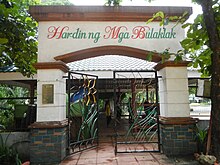
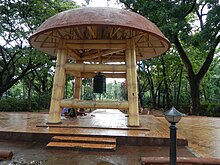

The elliptical park features smaller gardens and named green spaces within its grounds such as the Hardin ng Mga Bulaklak (lit. 'Garden of Flowers') and the Tropical Garden. The Quezon Memorial Circle also host a demo urban farm which in 2015 is occupying a 1,500 square meters (16,000 sq ft). The urban farm inside the park is one of the several sites under the "Joy of Urban Farming" project of Vice Mayor Joy Belmonte which was launched in 2010. In 2011, the Cactus and Succulent Garden designed by Serapion Metilla was opened to the public.
Among the other areas of the park is the World Peace Bell. The bell installed not before 1994, was a donation of the World Peace Bell Association, a Japanese organization promoting awareness on the world peace movement. The Philippines was the first Southeast Asian nation to receive a bell from the association. The first bell was made from coins donated by the then 65 member countries of the United Nations, weighs 365 kilograms (805 lb), has a height of 1.05 meters (3.4 ft), and a diameter of 60 centimeters (24 in). It was designed by the Quezon City Planning Office.
The bell was turned over to then Quezon City Vice Mayor Charito Planas by World Peace Bell Association Executive Chairman Tomojiro Yoshida at the Tsunamachi Mitsui Club in Tokyo on July 1, 1994. The bell was inaugurated by then President Fidel V. Ramos on December 10, 1994, who formally presented the bell to then Quezon City Mayor Ismael Mathay.
A Peace Monument was also erected inside the grounds of the park by the Rotary Club. It marked Quezon City as a Rotary Peace City as part of the "Community Peace Cities/Towns" concept conceived by the Rotary Club of Wagga Wagga, Australia. Quezon City is the fifth Rotary Peace Community in the Philippines and 25th in the world. The peace monument was inaugurated on December 7, 1999. The monument was removed due to the construction of the Quezon Memorial Circle Station of MRT-7.
The Philippine–Israel Friendship Park is hosted within the larger Quezon Memorial Circle beside the Quezon Heritage House. The park had its groundbreaking in December 2017 and was inaugurated in August 2018. It commemorate President Manuel L. Quezon's efforts to accept 1,000 Jewish refugees in the Philippines during the World War II era and the Philippines' support for the United Nations Partition Plan for Palestine and the establishment of the State of Israel.
Transportation
The Quezon Memorial Circle is totally engulfed by the Elliptical Road. A ₱49 million pedestrian underpass was opened in October 2007 which connects the lot occupied by the Quezon City Hall and the park. A second underpass connects the park to the Philcoa area near the Commonwealth Avenue amounted to ₱87 million and opened in December 2009.
The park will also host an eponymous station of the Manila Metro Rail Transit System Line 7 (MRT-7), which is under construction.
Vendors and stalls
As of 2017, the Quezon Memorial Circle hosts five restaurants and 13 food stalls. There are also 19 kiosks, 39 plant stalls, as well as 21 stalls from Agri-Aqua Network International. 7 other establishments also has presence in the park including the TEC bike rental, Pedal n Paddle Inc., and Philippine Mango Seedling. Following a planned redevelopment of the park by Mayor Joy Belmonte some stall vendors and restaurants surrounding the park's children's playground vacated the park after their permit expired on June 30, 2019. Within the same year, Belmonte launched the Fresh Market, a weekly farmer-to-consumer program, that would allow farmers from nearby provinces to sell produce to residents within the park.
Visitors

In 2012, it was reported that an average of 8,000 people visit the Quezon Memorial Circle daily. The average figures during the weekends were reportedly higher during the weekends amounting to 12,000 people. In December 2011, more than a million visited the park.
See also
References
- ^ "Introduction". Quezon Memorial Shrine. Retrieved February 27, 2016.
The Quezon Memorial Shrine is dedicated to the unrivalled legacy of the first president of the Commonwealth of the Philippines, Manuel L. Quezon. It is a national shrine highlighted by a 66-meter trylon monument at the heart of Quezon City's most important park. The monument's three columns and angels bowed in grief, holding sampaguita wreaths, represent Luzon, Visayas, and Mindanao. It has a museum that features Quezoniana relics and memorabilia, and a mausoleum where the remains of Quezon and his wife, Aurora Aragon Quezon, were interred.
- "Developments at the Quezon Memorial Circle". The Local Government of Quezon City. Retrieved February 27, 2016.
The Quezon City Government is continuously improving the Quezon Memorial Circle as a people's park and a fitting place for the shrine of a Philippine President. The place is not a forest park. On an ordinary day, when there are no special events there, an average of 8,000 people visit the park daily, with numbers increasing to 12,000 on weekends, and to over a million last December as more families chose to celebrate the holidays in affordable style outdoors.
- Quick Tour in Quezon City Memorial Circle Archived September 3, 2014, at the Wayback Machine
- Manila Bulletin - War aborts Capitol Building; 61st Anniversary of Quezon City.(Opinion/Editorial) by Isabelo T. Crisostomo
- Executive Order No. 79, s. 1945 (December 17, 1945), "Creating a Quezon Memorial Committee to Take Charge of the Nation-Wide Campaign to Raise Funds for the Erection of a National Monument in Honor of the Late President Manuel L. Quezon", Official Gazette of the Republic of the Philippines, retrieved February 27, 2016
- Executive Order No. 12, s. 1946 (August 19, 1946), "Reorganizing the Quezon Memorial Committee, Created under Executive Order Numbered Seventy-Nine, dated December 17, 1945", Official Gazette of the Republic of the Philippines, Malacañan Palace, Manila, Philippines, retrieved February 27, 2016
- Morato, Manuel (February 24, 2000). "Keep Circle as a park". Philippine Daily Inquirer. Retrieved August 3, 2016.
- "Federico S. Ilustre". Arkitekturang Filipino Online. Art Studies Foundation, Inc., National Commission for Culture and the Arts, and United Architects of the Philippines. Retrieved March 5, 2013.
- Panaligan, Marisse; Bartolome, Jessica (January 13, 2015). "REWIND: Looking back at previous papal visits in the Philippines". GMA News Online. Archived from the original on July 14, 2024. Retrieved July 14, 2024.
- ^ Jimenez-David, Rina (February 29, 2000). "What it takes to run a park". Philippine Daily Inquirer. Retrieved August 3, 2016.
- "Developments at the Quezon Memorial Circle". Quezon City Official Website. Quezon City Government. Retrieved August 3, 2016.
- "Quezon Memorial Circle to be converted into central park". ABS-CBN News. The Philippine Star. March 26, 2008. Retrieved August 3, 2016.
- Marquez, Consuelo (August 20, 2020). "ff-site dormitories for health workers open in Quezon Memorial Circle". Philippine Daily Inquirer. Retrieved August 26, 2020.
- "Free coronavirus testing for 60,000 Grab drivers, delivery riders". CNN Philippines. July 30, 2020. Archived from the original on July 31, 2020. Retrieved August 26, 2020.
- Lico, Gerard (2008). Arkitekturang Filipino: A History of Architecture and Urbanism in the Philippines. Quezon City: The University of the Philippines Press. p. 398. ISBN 978-971-542-579-7.
- Rowthorn, Chris; Bloom, Greg; Day, Michael; Grosberg, Michael; Ver Berkmoes, Ryan (2006). Philippines (9th ed.). Paris: Lonely planet. p. 85. ISBN 9781741042894.
- Montemayor, Ma. Teresa (August 19, 2018). "Presidential car museum opens in Quezon City". Philippine News Agency. Retrieved August 28, 2018.
- "DOT, city government team up to develop Quezon Memorial Circle". philstar.com. December 26, 2019. Retrieved December 31, 2019.
- ^ Royandoyan, Ramon; Ocampo, Karl Angelica (December 18, 2015). "12 ways to spend Christmas in Metro". Philippine Daily Inquirer. Retrieved August 3, 2016.
- Segova, Julius (reporter) (December 25, 2015). Playground, rides, tiangge at mga kainan, tampok sa Quezon Memorial Circle [Playground, amusement rides, flea market and dining venues, a hit at the Quezon Memorial Circle] (Television production) (in Filipino).
- Lacuarta, Gerald (February 13, 2000). "Disco at Circle hit". Philippine Daily Inquirer. Retrieved August 3, 2016.
- ^ Palma, Tadeo (June 22, 2012). "'Visit Quezon Memorial Circle'". Philippine Daily Inquirer. Retrieved August 3, 2016.
- "Flower, garden exhibit Feb. 4-15 in QC". Philippine Daily Inquirer. January 31, 2016. Retrieved August 3, 2016.
- Fritzie, Rodriguez (September 1, 2015). "#HUNGERPROJECT Making farming work in the big city". Rappler. Retrieved August 3, 2016.
- Fernandez, Rudy (August 7, 2011). "QC urban farming program expanded". The Philippine Star. Retrieved August 3, 2016.
- Bolido, Linda (September 11, 2011). "From classroom tutor to plant prof". Philippine Daily Inquirer. Retrieved August 3, 2016.
- Bacobo, Ariel (July 10, 1994). "Has Jaworski hurt his political ambitions - (Untitled subsection discussing the bell)". Manila Standard. Retrieved August 3, 2016.
- ^ Untitled (Marker). At the right portion of the south entrance of the World Peace Bell area in Quezon Memorial Circle.: Unknown. n.d.
{{cite sign}}: CS1 maint: year (link) - "Peace & Friendship Monuments Initiated by Rotary International". Peace Monuments Around the World (& Notable Peacemakers). Retrieved August 3, 2016.
- Rotary Peace City Project. ManilaStatues.com (Plaque on monument). Lower portion of the central monument on the side facing south.: Unknown. n.d.
{{cite sign}}: CS1 maint: year (link) - ^ "QC friendship park inagurated [sic]". Metro News Central. August 20, 2018. Retrieved May 27, 2019.
- "QC hosts PH-Israel Friendship Park". Philippine Information Agency. December 27, 2017. Retrieved December 27, 2017.
- del Rosario, Kenneth (October 2, 2007). "Underpass to Quezon Memorial Circle now open". Philippine Daily Inquirer. Retrieved August 3, 2016.
- "QC's 2nd pedestrian underpass opens Dec. 15". Balita. December 4, 2009. Retrieved August 19, 2019.
- Diega, Alladin (December 13, 2017). "Quezon Memorial Circle store tenants get contract extension". BusinessMirror. Retrieved March 6, 2018.
- "Joy's 'complete clean' washing in Quezon Circle". ABS-CBN News. August 9, 2019. Retrieved September 5, 2019.
- Embudo, Franz Lewin (December 29, 2019). "Quezon City: Problems solved". Manila Times. Retrieved December 30, 2019.
External links
 Quezon Memorial Circle travel guide from Wikivoyage
Quezon Memorial Circle travel guide from Wikivoyage Media related to Quezon Memorial Circle at Wikimedia Commons
Media related to Quezon Memorial Circle at Wikimedia Commons- Quezon Memorial Circle at OpenStreetMap
| Parks and plazas in Metro Manila | ||
|---|---|---|
| Protected areas | 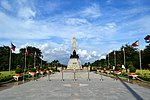 | |
| Urban parks |
| |
| Nature parks | ||
| Squares and plazas |
| |
| Visitor attractions in Metro Manila | |
|---|---|
| Historical sites | |
| Religious buildings | |
| Museums and galleries |
|
| Integrated resorts | |
| Amusement |
|
| Parks and gardens | |
| Shopping | |
| Events and traditions | |
| Event venues | |
| By type | |
